History
This site began life as Robert le Ffrere's shop around 1240, rented by him for one pound of cumin paid annually. About 40 years later it was acquired by Edmund of Lancaster, (Edmund Crouchback, brother of Edward I), and he granted half a mark yearly, out of the profits, to maintain a lamp burning day and night before the altar of the Holy Cross in the parish church. It was said that the lamp was still burning two hundred years later, but by 1613 the shop had become the brew house for St Mary's Priory Church, Monmouth. By 1700 it was an inn with the appropriate name of The Angel. It remained The Angel Inn until 1965, an extraordinarily long existence for an inn, when it was returned to its former use as a shop. [3]
In 1720, when the landlord was John Roome, one of his customers stole two pewter plates and a flaxen napkin. She was caught and whipped at the cart's tail around the town. In 1804, Charles Heath was plainly impressed by the inn, since he wrote: "The Angel Inn kept by Mrs Pugh, has long been a house of great respectability, and frequented by the mercantile travellers of the kingdom, whose business connects them with the trading part of the borough, - and is but justice to add, that her kind attention to her guests, has long secured her the highest place in their good opinion". [3]
The inn was nearly destroyed in 1857 when a disgruntled jockey, who had been beaten at Monmouth Races, tried to set fire to the winning horse which had been stabled there. He was caught in the act and convicted. [3]
The Angel had several Friendly Societies, and a Society of Tradesmen and Others met there in 1794. Later, the Black Swan Friendly Society transferred to it, and in 1850 the Sons of Equity met there. In 1884, the landlady, Mrs Creeper, advertised the fact that "The omnibus passes the door to meet every train". These were the coaches from the King's Head Hotel and Beaufort Arms Hotel which called at the Angel Hotel to pick up passengers. At one time, cycle touring was a popular pastime along the Wye Valley, and the Angel became the headquarters of the Monmouth Branch of the Cyclists Touring Club. Together with the Beaufort and King's Head, the Angel became a Trust House Hotel in the mid- 20th century and closed around 1965. [3] It remained The Angel Inn until 1985, when it closed and was extensively altered in its conversion to a furniture showroom. [1]
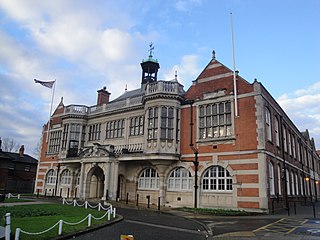
Hendon is an urban area in the Borough of Barnet, northwest London 7 miles (11 km) northwest of Charing Cross. Hendon was an ancient manor and parish in the county of Middlesex and a former borough, the Municipal Borough of Hendon; it has been part of Greater London since 1965. Hendon falls almost entirely within the NW4 postcode, while the West Hendon part falls in NW9. Colindale to the northwest was once considered part of Hendon but is today separated by the M1 motorway.

Llan Ffestiniog, also known as Ffestiniog or simply Llan, is a village in Gwynedd, Wales, lying south of Blaenau Ffestiniog. Llan Ffestiniog is the older of the two communities, with its church and other buildings predating most of Blaenau Ffestiniog. The population was given as 864 in the 2011 census.

Coleford is a market town in the west of the Forest of Dean, Gloucestershire, England, two miles (3 km) east of the Welsh border and close to the Wye Valley. It is the administrative centre of the Forest of Dean district. The combined population of the town's two electoral wards at the 2011 census was 8,359. The population of the town's parish was 9,273 in the 2021 Census. The parish includes the village of Baker's Hill.

The Stagecoach Inn Museum in Newbury Park, California, originally known as the Grand Union Hotel, was used as a resting area for people who traveled from Los Angeles to Santa Barbara. Besides a hotel and stagecoach stop, it has also been used as a post office, church, restaurant and military school. It is California Historical Landmark No. 659 and is listed in the National Register of Historic Places. It played a major role in the development of the stage line transportation network in California. The hotel was also the first business venture in the Conejo Valley.
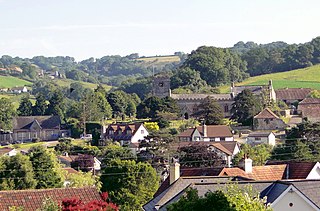
Uplyme is an English village and civil parish in East Devon on the Devon-Dorset border and the River Lym, adjacent to the Dorset coastal town of Lyme Regis. It has a population of approximately 1700 recounted as 1663 at the 2011 census. Uplyme is situated in the electoral ward of Trinity whose population at the above census was 2,521.
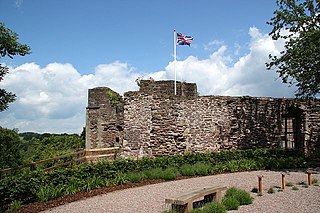
Monmouth Castle is a castle close to the centre of the town of Monmouth, the county town of Monmouthshire, on a hill above the River Monnow in south east Wales.

Brockweir is a village in Hewelsfield and Brockweir civil parish, in the Forest of Dean District of Gloucestershire, England. The civil parish also includes the separate village of Hewelsfield.

The Shire Hall in Agincourt Square, Monmouth, Wales, is a prominent Grade I listed building in the town centre. It was built in 1724, and was formerly the centre for the Assize Courts and Quarter Sessions for Monmouthshire. In 1839–40, the court was the location of the trial of the Chartist leader John Frost and others for high treason for their part in the Newport Rising. The building was also used as a market place. The Shire Hall is owned by Monmouthshire County Council and has audiovisual guides for visitors to Courtroom 1. It is currently used as a Tourist Information Centre and as the offices for Monmouth Town Council, and is open to the public in part.
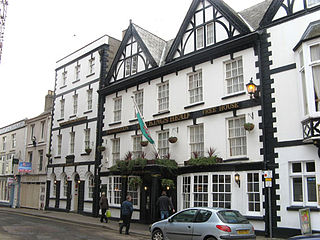
The King's Head Hotel is a hotel standing opposite the Shire Hall in Glyndŵr Street, Agincourt Square, Monmouth, Wales. It dates from the mid-17th century, and as one of the major inns in Monmouth was reputedly visited by Charles I of England in 1645. It has a fine black-and-white painted stone façade and became an important posting inn in the late 17th century, with a yard through an archway where visitors' horses could be stabled and where regular coach services called. In the 18th and 19th centuries, stagecoaches for London left from the inn. The range of buildings along Agincourt Street now includes the former Monmouth Bank and the County Club, while the inn itself is now part of the J D Wetherspoon pub chain. It is one of 24 buildings on the town's Heritage Trail and is a Grade II* listed building.
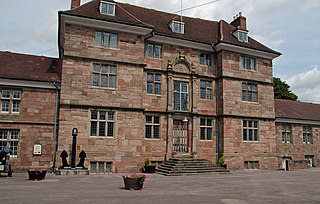
Great Castle House is a former town house built on the site of part of Monmouth Castle in Wales. Amongst the town's most significant buildings, it has a Grade I listing and is one of 24 sites on the Monmouth Heritage Trail. The house is located on Castle Hill, off Agincourt Square in Monmouth town centre.
The Monmouth Heritage Trail is a walking route which connects various sights in the town of Monmouth, Wales.
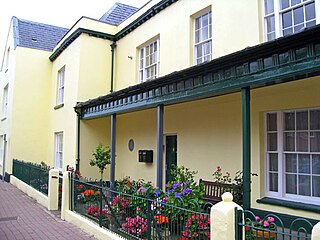
The Judges' Lodgings, located in Whitecross Street, Monmouth, south east Wales, is an eighteenth-century building, with earlier origins, on the edge of St James' Square. It has its origins as an early 16th-century town house, becoming the 'Labour in Vain' inn around 1756. It was in use as the Judges' Lodgings for the Monmouth Assizes before 1835, and as the Militia Officers' Mess in the 1870s. Today it is a private house, with modern mews cottages built into the rear. It is a Grade II listed building and is one of 24 blue plaque buildings on the Monmouth Heritage Trail.
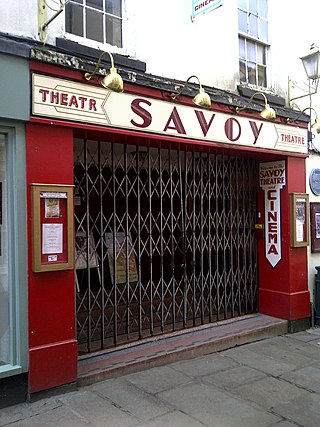
The Savoy Theatre, Church Street, Monmouth is a theatre and cinema, reputedly the oldest working theatre site in Wales. It has a capacity for 360 people and is run by a charitable trust. One of 24 buildings on the Monmouth Heritage Trail, the theatre is a Grade II* listed building.
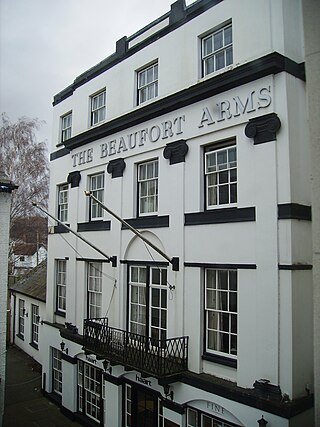
The Beaufort Arms Hotel, in Agincourt Square in the town of Monmouth, south-east Wales is a former coaching inn dating from the early eighteenth century. The frontage was modified in the 1830s, possibly by the prolific early Victorian architect George Vaughan Maddox. A stone cornice on the central block carries the inscription "The Beaufort Arms". A Grade II* listed building, it features in the Monmouth Heritage Trail. In the 20th century, the building was converted to residential apartments.

Agincourt House, No. 1 Agincourt Square, Monmouth, Monmouthshire, Wales is a notable early seventeenth century half-timbered building.

Hyam's Mineral Water Works is a nineteenth century building at 23 Glendower Street, Monmouth, Wales. Formerly a mineral water works, it is currently used as residential apartments. The building holds one of the 24 blue plaques awarded by the Monmouth Civic Society to buildings of especial historical and social interest, and features on the Monmouth Heritage Trail.

The White Swan Inn, White Swan Court, Church Street, Monmouth, Monmouthshire, south-east Wales, is an eighteenth-century former coaching inn. The building is Grade II* listed as of 27 June 1952. It is one of 24 buildings on the Monmouth Heritage Trail.

George Vaughan Maddox was a nineteenth-century British architect and builder, whose work was undertaken principally in the town of Monmouth, Wales, and in the wider county. Working mainly in a Neo-Classical style, his extensive output made a significant contribution to the Monmouth townscape. The architectural historian John Newman considers that Monmouth owes to Maddox "its particular architectural flavour. For two decades from the mid-1820s he put up a sequence of public buildings and private houses in the town, in a style deft, cultured, and only occasionally unresolved." The Market Hall and 1-6 Priory Street are considered his "most important projects".

Church Street is a pedestrianised street in the centre of Monmouth, Wales. It contains a variety of independent shops, restaurants, commercial art galleries, and the Savoy Theatre. Until the 1830s, when Priory Street was built to bypass it, it was the main thoroughfare into the centre of Monmouth from the north-east, linking the market and the parish church. It was at one time the centre of the town's butchery trade and was known as Butcher's Row.
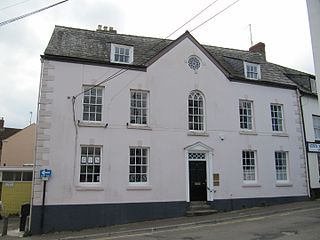
9 Agincourt Street, Monmouth, Wales is a late 17th century townhouse which became the estate office of the agent of the Dukes of Beaufort in the mid 19th century. It is a Grade II* listed building. In commercial use since its construction, it now houses a firm of architects.




















